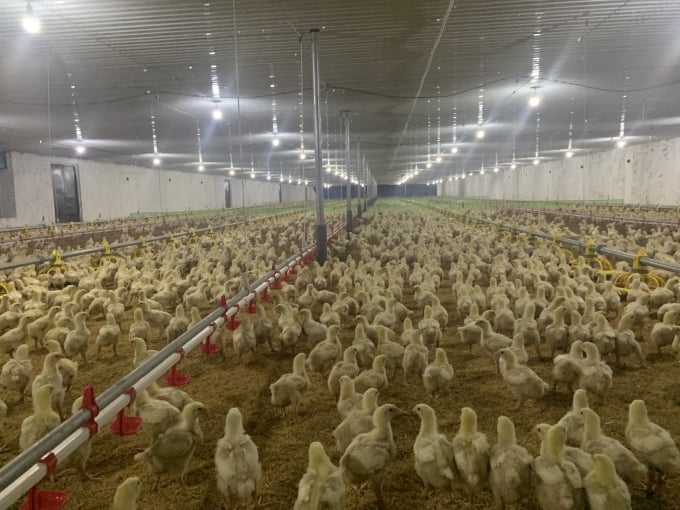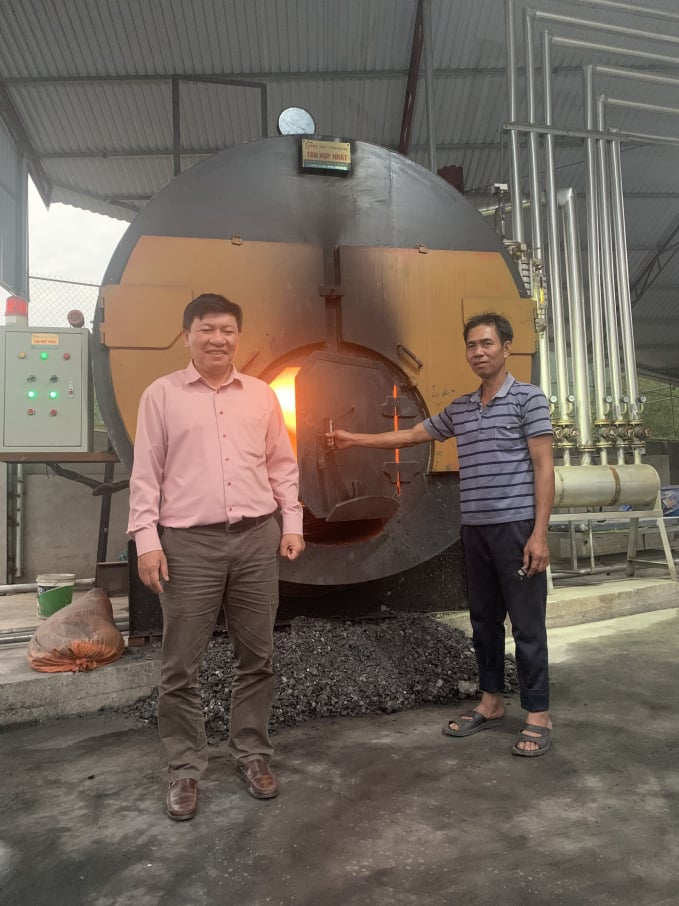November 25, 2025 | 21:24 GMT +7
November 25, 2025 | 21:24 GMT +7
Hotline: 0913.378.918
November 25, 2025 | 21:24 GMT +7
Hotline: 0913.378.918
The chicken farm serving as a distribution channel for Vietnam CP Foods JSC in Thuong Yen Cong commune, Uong Bi city (Quang Ninh) is one of the high-tech agricultural models of Mr. Nguyen Ton Quyen. The farm’s scale is currently 45,000 chickens/batch, 8-9 batches/year, having annual revenue of over VND 1 billion.
The basis to ensure the effectiveness of this chicken farm lies in the application of modern technology. The farm uses a cooling system in the summer and a heating system in the winter, with air circulation fans operating continuously for ventilation. There is also a disease detector system, a lighting system, a machine that distributes and delivers food and water to the chicken, etc. Mr. Quyen’s chicken cultivation technology is considered the most modern technology to date.

The farm’s scale is currently 45,000 chickens/batch, 8-9 batches/year. Photo: Dinh Muoi.
Mr. Quyen shared that the equipment is mostly imported from Denmark. Although the initial investment is high, the advantages in return are many. This model ensures accuracy in terms of parameters and can be used sustainably, long-term, and cost-effectively. In addition to equipment and technology, direct workers as well as farm supervisors always pay great attention to the implementation of sanitation and disease prevention for chickens. The chicken samples are taken weekly and sent to the company’s laboratory.
Thanks to this farming technology, in the entire 45-day life cycle the chickens live in a safe, disease-free and nutritious environment. The agricultural product is accordingly assessed to be qualified and suitable for consumers' health.

Mr. Nguyen Ton Quyen (left) introducing the boiler that keeps chickens warm in winter. Photo: Dinh Muoi.
With the current scale of 6 cages, the initial investment cost of Mr. Quyen's chicken farm has gone up to VND 30 billion. Aiming to double the farm’s size, his second investment phase is under preparation with a total investment of VND 80 billion, ensuring a total flock of about 90,000 chickens/batch. Another VND 40 billion will be mobilized for the third investment phase to spend on building food processing facilities, concentrated slaughterhouses, cold storage to preserve products, develop direct distribution channels to the market. Fruit trees will be planted to effectively utilize chicken by-products.
Mr. Quyen's ambition is to have a total flock of 500,000 chickens/year in Uong Bi by 2025 and his own chicken brand in the market.
Mr. Nguyen Ton Quyen said: “During the initial production stage the high-tech chicken raising model has a high investment rate compared to revenue and profit. However, this model holds great potential for sustainable development. More importantly, in the long run, when investment and operation costs reduce, profits and interest rates will be higher, bringing income to farmers.” In Mr. Quyen’s calculation, the payback period will be more or less 8 years.
All workers in Mr. Quyen's high-tech chicken farm, although relatively young, have long experience in the profession. Thanks to that, in the context of Covid-19’s complicated situation, despite being unable to directly manage the work, he still feels somewhat secured.
Translated by Samuel Pham
/2025/11/25/0045-1-135246_13.jpg)
(VAN) Ca Mau is researching a model of sea-encroaching embankments combined with viaducts and logistics service zones, aiming both to prevent erosion and create land funds for marine economic development.

(VAN) The information was shared at the seminar 'Urban Agriculture - Solutions for Developing Green Spaces,' organized by the Kinh te & Do thi Newspaper and the Biotechnology Center of Ho Chi Minh City.
/2025/11/19/4141-2-132831_216.jpg)
(VAN) One of Japfa's outstanding solutions is implementing digital transformation and artificial intelligence (AI) to optimize operations, enhance productivity, and advance sustainable development.
/2025/11/19/4847-1-093540_448.jpg)
(VAN) The Gia Lai Provincial People’s Committee had a working session with the delegation of the U.S. Department of Agriculture, the State of Idaho, and representatives of the State's leading enterprises.

(VAN) Ca Mau has a sufficient foundation to become a strong regional aquaculture center, where production integrates the economy, the environment, and the lives of the people.

(VAN) SEIKI Group envisions itself as a pioneer in the ‘dual transformation’ of digital technology and green industry, standing alongside the Government and Vietnamese businesses in their pursuit of sustainable development.

(VAN) The VNGEONET network affirms Viet Nam's progress in mastering digital space, providing a precise positioning data platform to serve socioeconomic development.